Every night could be an aurora night. Don't Miss Out
Iceland’s Highlands — Europe’s last frontier with Mother Nature. An untouched swath of uninhabited wilderness in Iceland, the Highlands' natural beauty shines through mountains and hills that mark the borders with other regions. Behind the rugged Icelandic terrain hide Iceland’s glaciers, streams like Tungnaá, and volcanoes, waiting to be uncovered and discovered on hikes and week-long treks.

Ófærufoss near Highland’s Laugavegur Trail. Source: Gunnar Gaukur.
Despite their rough exterior, the Highlands in Iceland house heartwarming sights behind every climb and decline. Wonders like lava fields, obsidian deserts, and geothermal hot spots unpeel the region's toughness like an onion to reveal a long-lasting, charming core. Though hiking in Iceland is challenging, no step goes unrewarded in the island's interior, making it one of the best places in Iceland for your trekking dreams. Discover what’s waiting in the great wilderness through these Icelandic Highlands attractions:
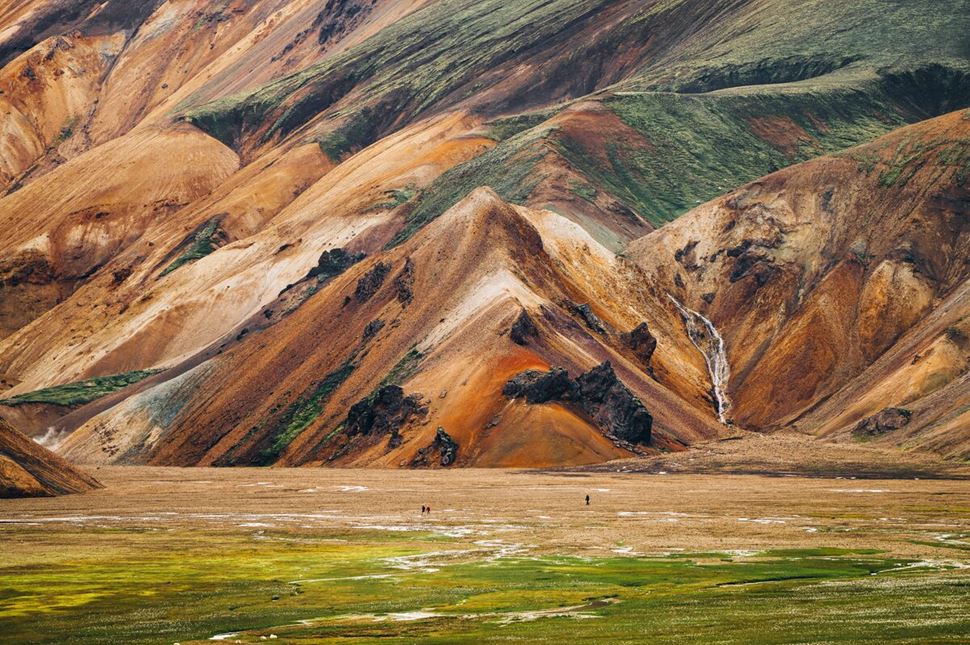
Colorful mountains accompany hot springs in Landmannalaugar. Photo by Gaukur.
An area inside Fjallabak Nature Reserve in the southern parts of the interior. Landmannalaugar geothermal area is best known for the warm waters that acted as a resting point for Highland travelers or short-term visitors—hence the name “People’s Pools.” Hiking in Landmannalaugar pairs nicely with a dip in the flowing geothermal river, the only safe place for swimming in the area. Sightseeing possibilities open up on the Laugavegur trail, where the Landmannalaugar hot springs act as a starting point.
Ideal for: A day hike followed by a relaxing soak in the natural hot springs.
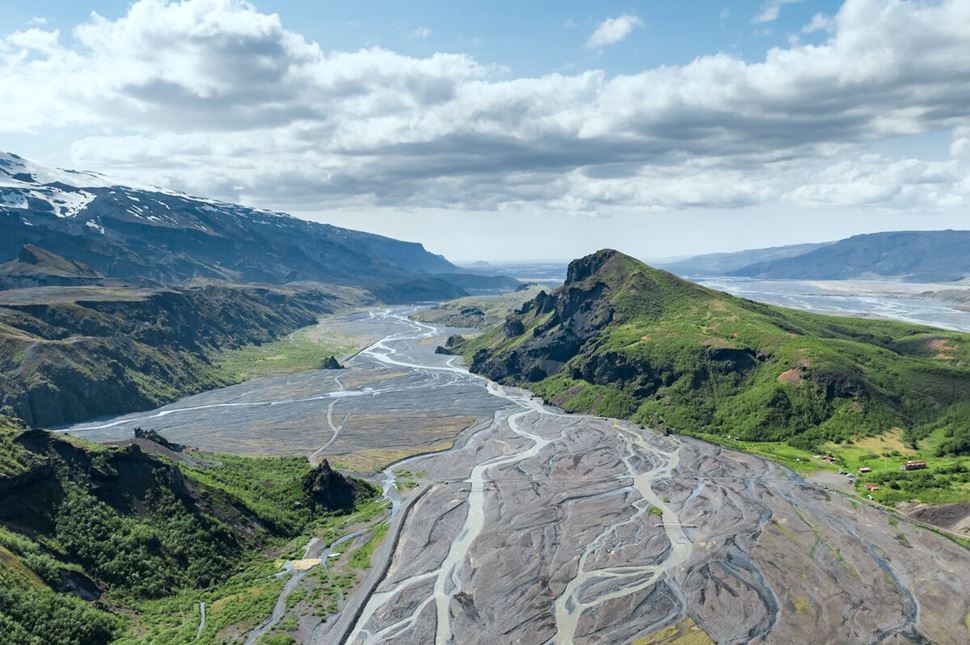
Branching streams and green mountains of Þórsmörk. Source: Arctic Adventures.
The lush heart of Iceland, tucked in between the giant Mýrdalsjökul, infamous Eyjafjallajökull, and melting Tindfjallajökull glaciers. Known for its otherworldly beauty, Þórsmörk nature reserve's landscape is characterized by glacier rivers and mountains with green slopes. Besides the views, people can enjoy summer hiking in Þórsmörk or spend the night in one of the immersive mountain huts. Most visitors come to Þórsmörk valley on the way to complete Iceland’s highlands trail, Laugavegur, or begin the Fimmvörðuháls path.
Ideal for: A thrilling hike or multi-day trek through Þórsmörk’s glaciers, rivers, and lush valleys, perfect for those seeking a true connection with nature.
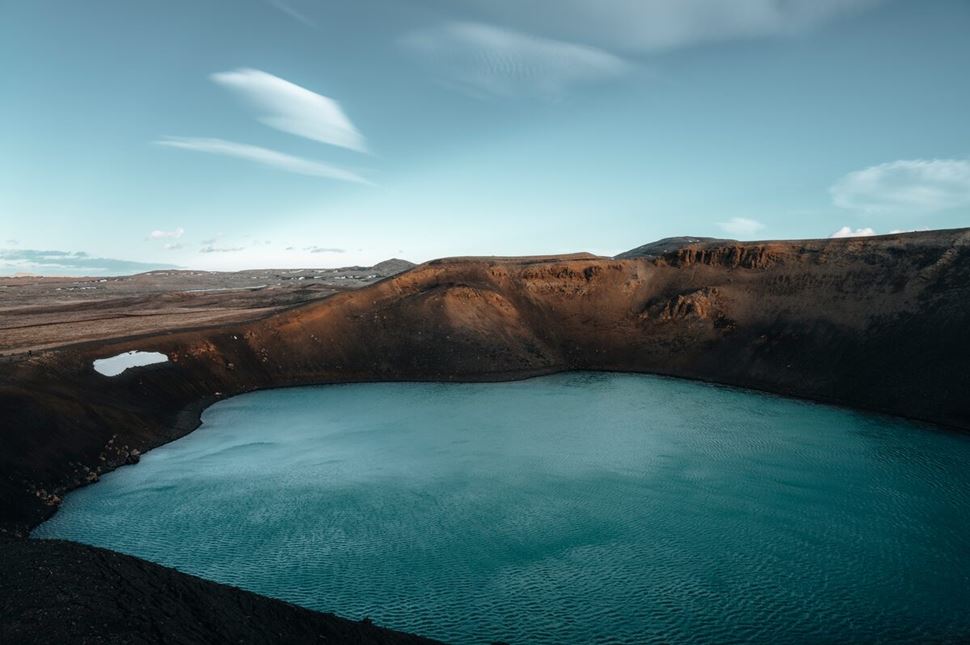
Hills around the blue water of Viti crater in the Highlands. Photo by Gunnar Gaukur.
A pair of volcanic depressions north of the Vatnajökull glacier in the Dyngjufjöll mountain range. Askja caldera came about in 1875 after a series of volcanic eruptions and is now home to Lake Öskjuvatn, one of Iceland's deepest bodies of water. Víti crater lake, north of its big brother, formed around the same time, but instead of blue water, warm, white-colored liquid fills the hole. You can visit these Icelands Highlands must-see sights, along with the Holuhraun lava field, on a single-day excursion with us.
Ideal for: A guided 4x4 summer day tour to Askja and Víti Crater with a short hike and crater-edge soak.
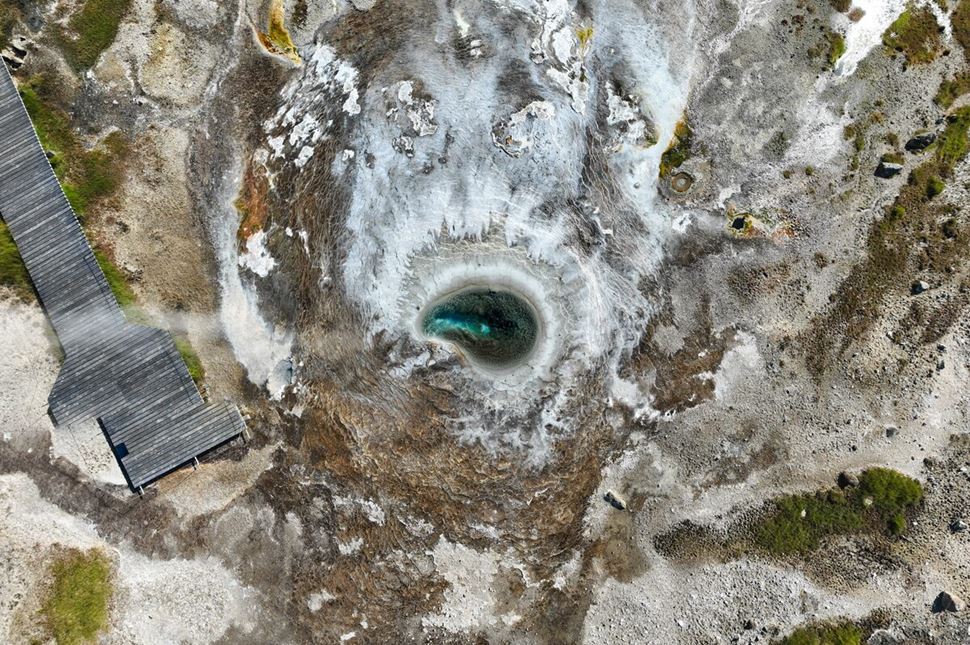
Deep blue hot spring in Hveravellir geothermal area. Image taken by Gunnar Gaukur.
A warm water spot in the corridor between the Langjökull ice field and Hofsjökull's snowy cap. One of the most remote geothermal areas in Iceland, the Hveravellir hot springs are well developed, with a lodge and a café, both ready to welcome tired travelers. The whole Hveravellir nature reserve is characterized by steaming fissures, a sign of ongoing volcanic activity below the surface. Average Hveravellir hiking experiences are flavored with geothermal baths and Icelandic sheep in summer.
Ideal for: A relaxing geothermal getaway with light hiking and an overnight stay at Hveravellir.

Steaming paths of the Kerlingarfjöll mountain cluster. Source: Arctic Adventures.
An Icelandic mountain range in the middle of the country near the Hofsjökull glacier. Behind the rising terrain is Kerlingarfjöll geothermal area, Hveradalir, where boiling waters meet colorful slopes. Though remote and hardly accessible in winter, the Kerlingarfjöll mountain resort is a luxurious spot to stop and rest up. For those driven by adventure, hiking in Kerlingarfjöll is an unforgettable option, as each trail through this geothermal landscape in Iceland is met with steam and heat.
Ideal for: A captivating expedition through the Kerlingarfjöll Mountains, perfect for those craving to explore vibrant geothermal landscapes and the soothing embrace of striking hot springs.
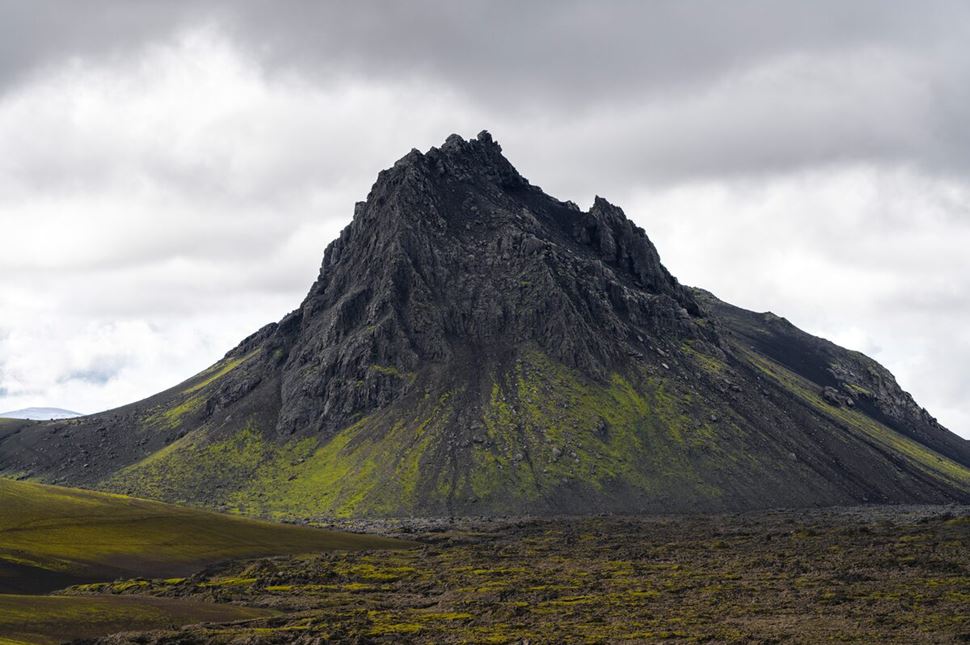
Volcanic formation of ash in the Hekla area. Photographed by Gaukur.
An active volcano in Iceland near the Fjallabak Nature Reserve and the Landmannalaugar area. Since the 10th century, around 20 Hekla eruptions have rocked the area, leaving a vast lava field to mark their presence. Unlike other Icelandic highland volcanoes, the so-called “Gateway to Hell” is closer to the inhabited parts of the island. Though hiking near Hekla volcano requires an expert guide for safety and navigation reasons, no one is stopping you from inspecting the destructive creation from a distance.
Ideal for: A quick stop on the way to Landmannalaugar geothermal area if coming via mountain road F225.
Þjórsárdalur vale is located between Þórsmörk and Langjökull glacier in the southern parts of the Highlands. An oasis of lush nature in Iceland’s Highlands, the plateau of Thjorsardalur Valley is intercut by Þjórsá River (the longest river in Iceland) and surrounded by rising hills. The views in the region culminate at the 122 m (400 ft) tall Háifoss waterfall (one of Iceland's tallest waterfalls). While you’re here, pass through cultural sites like the Þjóðveldisbær farm ("Medieval Farm" or "Viking Age Farm"). If you’re a fan of dragons, you might recognize it as one of the set pieces for Game of Thrones.
Ideal for: Scenic hikes through lush valleys, waterfall viewing, and exploring Viking heritage sites.
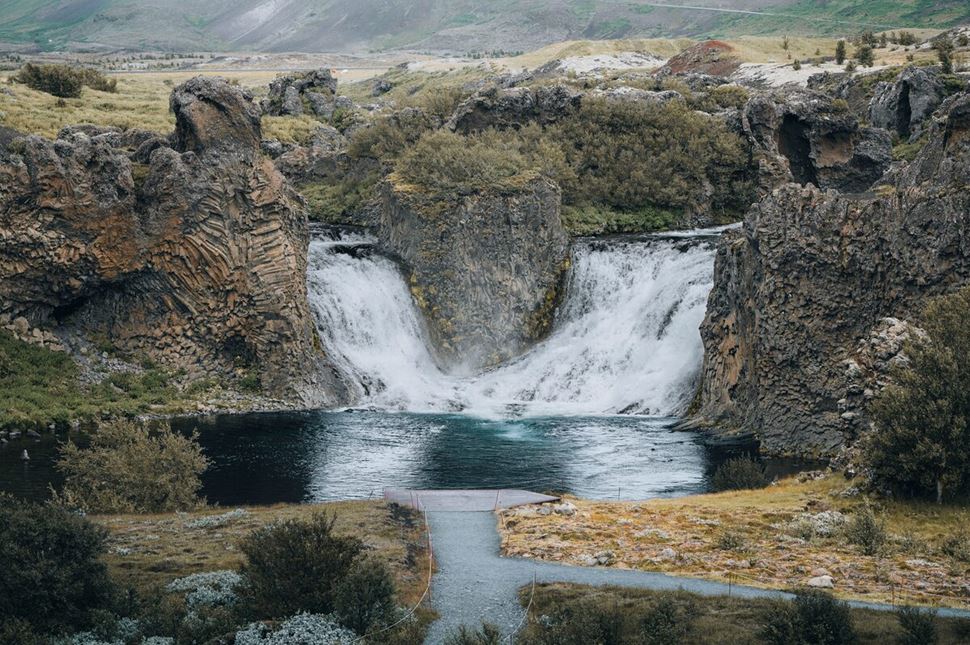
Dual falls of Hjálparfoss in Þjórsárdalur Valley. Source: Gunnar Gaukur.
The rocky deserts in Iceland and the slopes of the Highland mountains surrounding them ooze with adventurous possibilities. A trip through the interior is incomplete without a healthy dose of hiking. If you’re craving a more thorough experience, organized Iceland highlands tours from Reykjavik with a Super Jeep contain a mix of knowledge, comfort, and excitement. And when you’re done with the adventure, indulge in relaxation by dipping into some of the hot springs found throughout the region. Regarding things to do in the Icelandic Highlands, here are some of the more popular activities:
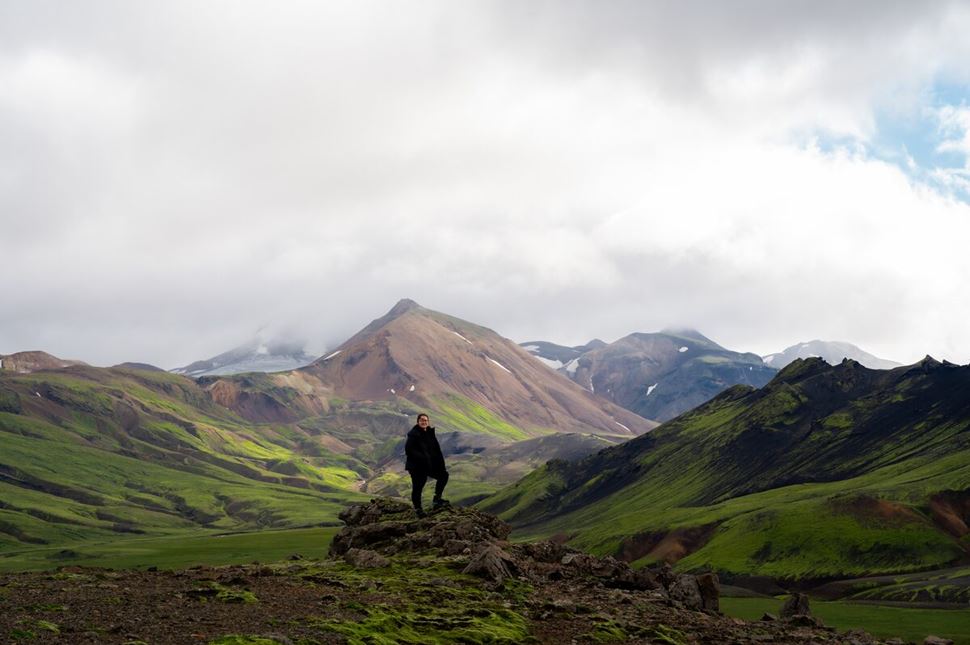
Trail peak with a panoramic view of the Icelandic Highlands. Captured by Arctic Adventures.
Go on the best hikes in Iceland and work up a sweat by climbing mountain slopes and passing through large plateaus of the island's interior. Highlands trekking routes come in different difficulties and lengths, with the iconic Laugavegur trail remaining a gold standard for trekkers worldwide. Start with the tracks around Landmannalaugar rhyolite mountains and finish in the lushness of Thorsmork. Extend the 3–4 day long journey with a Fimmvörðuháls hike to the waterfalls of Skógar village. Experience all of this on Icelandic Highlands day tours with an expert guide. Looking for more spice? Walk the banks along the Tungnaá river on private excursions.
Leave the logistics to us and join guided Highland tours, where a small-group vibe only deepens the excitement. Expertly planned Super Jeep tours in Iceland allow you to explore the island's interior even in just one day. Together with a guide, drive up to the boiling waters of Landmannalaugar to meet the famous rainbow slopes and hot springs. If you crave to see more greenery, navigate the valleys of Thorsmork in a specialized vehicle. Looking for something more bumpy? Book an off-road adventure to Iceland’s Askja caldera from Mývatn lake.
Favored by Icelanders for generations, the remote Iceland's natural hot springs have long been a place to rest tired legs and reset the mind. The natural warming baths are scattered across Iceland’s interior, where people give way to vegetation and the atmosphere hums with the quiet tunes of remoteness. Dip into the Landmannalaugar hot springs, waters long associated with retreat and relaxation. Or visit a hot spring at Kerlingarfjöll’s Base or Ásgarður valley and treat yourself to a view-filled soak. Either way, geothermal bathing in the Highlands is a rewarding way to wrap up a hike or a day of exploring.
Late May to mid-September marks the best time to visit the Icelandic Highlands and the high season for travel to the island overall. Improved weather conditions usher in flourishing nature and the opening of the F-roads, enhancing the Highlands' accessibility. However, clouds and rain may impact seasonal activities like hiking and the visibility of distant glaciers in Iceland’s uninhabited Highlands. The situation becomes more dramatic between September and April–Iceland’s highlands winter window. It’s the time of the year when the region transforms into a fortress of solitude. Snow and ice close down the roads, mountain huts become uninhabited, and travel is restricted to Super Jeep Iceland highlands tours.
Even in summer, the gorgeous views of the Highlands in Iceland come with a degree of challenge. While the irrational climate can be dealt with by packing proper equipment and wearing layered clothing, transportation is a problem that keeps on giving. Besides following Iceland's driving rules and tips, you’ll have to deal with uneven terrain, gravel roads, and several glacial passings—a killer combo for simple 2WD. While renting out a 4x4 and venturing into the interior is possible, understanding the risks is even more important in these parts!
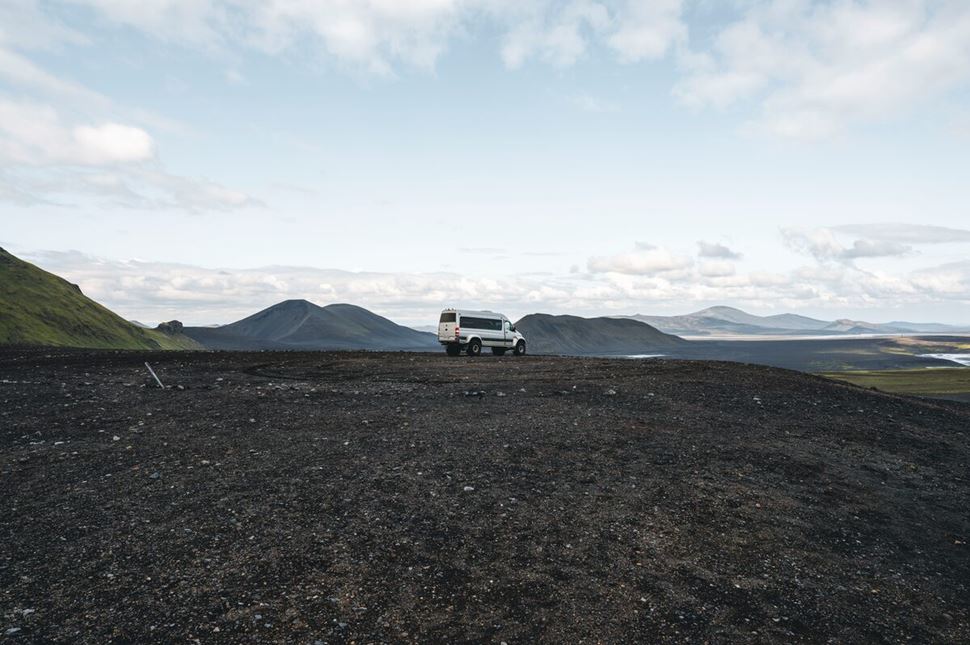
A suitable vehicle for the rough Highland F-roads. Source: Arctic Adventures.
Highlands 4WD requirement is enforced by law, since simple 2WD vehicles can’t handle gravel surfaces and the environmental dangers of the region. Most guided tours in Iceland's Highlands use a 4x4 or Super Jeep, as they are more appropriate for passing the Tungnaá river and shifting landscapes. Still, you can rent a car and go on a self-driving adventure or travel with a Highland bus in Iceland to spots like Thórsmörk.
Driving in the Highlands involves navigating F-roads in Iceland—gravel pathways connecting the island's middle and coastal regions in summer. These are considered Iceland's 4x4 roads, since uneven terrain is just one part of the problem. A drive through F208 (among other numbered paths) means traveling over glacial rivers like Tungnaá, where your speed decreases as you navigate through flowing water. While websites like Umferdin track the conditions of the roadways, here’s a basic rundown of the main ones you might encounter:
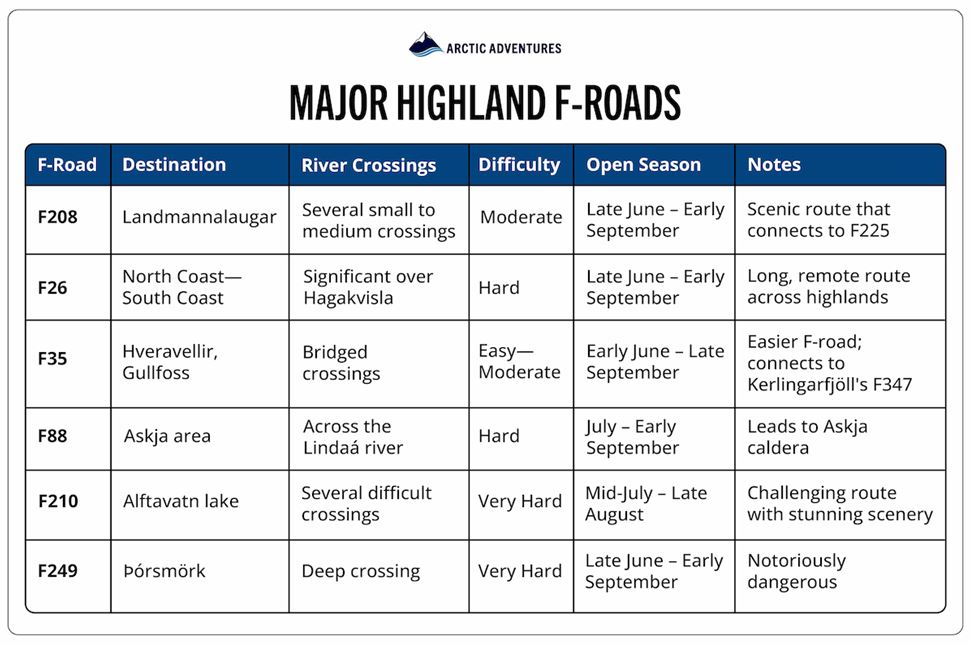
List of the main F-roads in the highlands of Iceland. Source: Arctic Adventures.
The Highland road map consists mainly of F208, F26, F35, F88, F210, and F249, among many more branches. F26 and F35 are the longest, connecting the south with the north. F208, F88, F210, and F249 are localized, focusing on attractions like Landmannalaugar, Askja, Alftavatn, or Thorsmork. F210 and F249 are the roughest, since they pass through deep river crossings. F88 and F26 are a step lower in difficulty, while F208 and F35 are the easiest, with shallow or bridged flow overpasses. Most F-roads open up in June or July at the latest, and close down in August or September.
The map of Iceland's Highlands is defined by significant gaps of remoteness and lack of infrastructure. Leading roads like F35 and F26 cut through the barren lands of scenic hills and deserts, connecting major landmark areas with the Ring Road. Southern parts of Iceland's interior are the most wonder-dotted, with Þjórsárdalur valley, Landmannalaugar geothermal area, Thórsmörk nature reserve, and the silent lands of Hekla volcano grabbing attention. Hofsjökull, the temple glacier, Hveravellir field, and Kerlingarfjöll steaming mountains occupy Iceland’s central highlands. In the northeast, the desolate landscape gives way to the blue beauties of Askja caldera and Víti crater right near it.
One factor is uncontrollable—the climate. Weather conditions in Iceland's Highlands are subject to rapid change, as it might rain or even snow one moment and be all sunshine the next. Usual preparedness for Highlands trips starts with packing the essential equipment and using the limited space effectively. Skip casual attire and opt for practical layering: a moisture-wicking base, an insulating middle layer, and a weatherproof outer shell. Sturdy hiking shoes are much better in this climate’s rougher interior terrain. For added Highlands travel safety assurance, track weather forecasts online and inform others where you plan to go (i.e, Laugavegur Trail, Landmannalaugar, and so on).
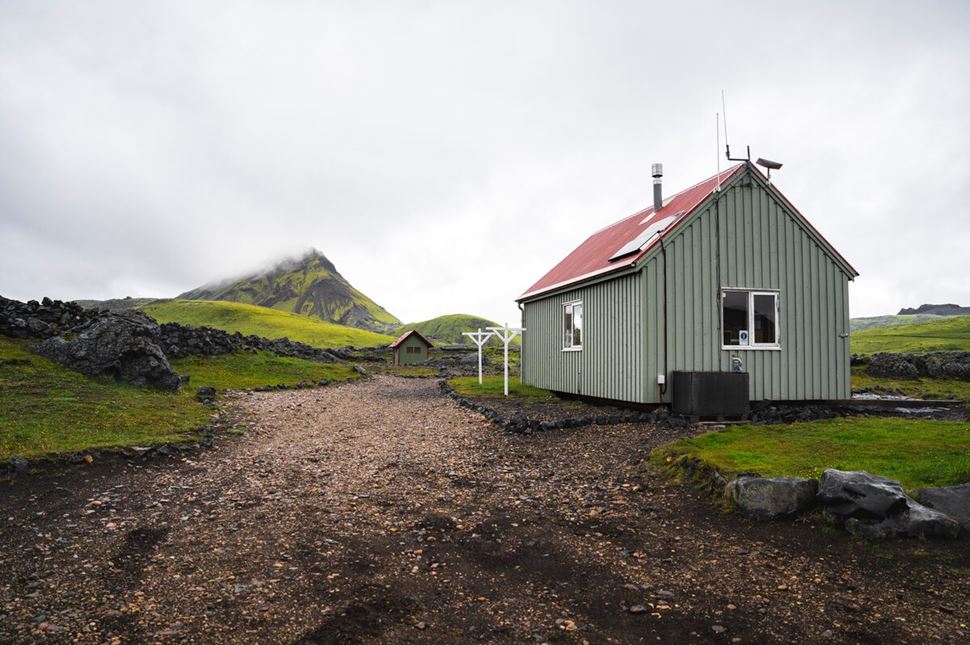
Hvannagil mountain hut in the wilderness of the Highlands. Photo by Gaukur.
Icelandic highlands lodging is limited but immersive, and mostly nestled near popular tourism sites. For example, Iceland’s Highlands huts are dotted along the Laugavegur trail and in the valleys of Thórsmörk. Luxury does exist in this remoteness, with places like Iceland Highland Base offering a hotel experience in the mountains of Kerlingarfjöll. A more rustic alternative, outdoor sleeping in a tent by camping in the Highlands of Iceland immerses you in the chaotic beauty of nature. However, you’ll have to carry a tent and other equipment. Regardless of your choice, booking well in advance is essential, especially during the summer, when spots in accommodations are often sold out. Below is a more detailed comparison of Highland housing options:
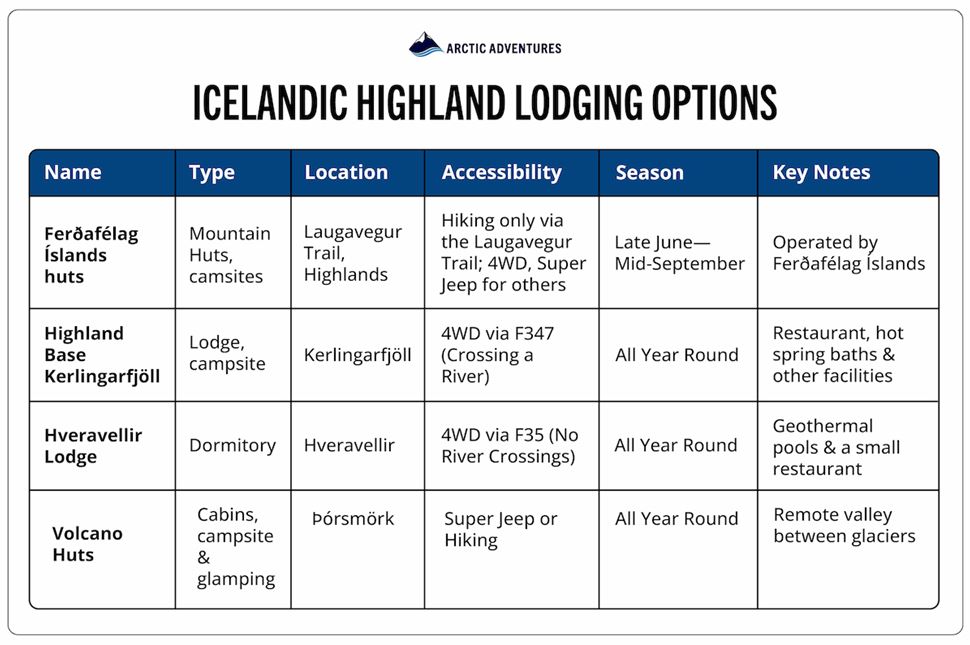
Accommodation in the Highlands of Iceland. Source: Arctic Adventures.
Ferðafélag Íslands operates staffed Highland huts in Iceland from late June to mid-September, accessible by foot or sturdy 4x4 vehicle. Near Kerlingarfjöll, Highland Base offers a hotel, hostel, sauna, and hot springs, and is reachable via F347 in summer. Hveravellir features two huts: one with private rooms, the other dormitory-style. Þórsmörk’s Volcano Huts provide cabin rooms, complete cottages, and glamping options. Designated campsites can be found near each of the accommodations.
Far from modern civilization, Iceland’s Highlands area is free of massive light sources, so the pollution for aurora viewing is minimal. If the skies are clear (and dark enough), distant galaxies and bright white stars open up while stargazing in the Highlands from places like Þórsmörk. Or, from September to April, when Aurora viewing in Iceland becomes popular, look for the colorful dance in the celestial dome above. However, the appearance of Northern Lights in Iceland's Highlands still depends on solar activity, a factor that is unpredictable and random.

Mýrdalsjökull ridges peaking through the clouds/fog. Captured by Gunnar Gaukur.
Myths in the Highlands play into the remote nature of the region. It’s a go-to spot for criminals like Fjalla-Eyvindur and, if elf stories in Iceland are to be believed, the Huldufólk. These hidden creatures rest under rocks, and tourists report hearing them making noises throughout the area. According to Icelandic mythology, no matter how cute they appear, they’re always ready to punish those who disrespect the environment by trashing and harming it.
The Highlands in Iceland are vast, raw, and untamed—a place where nature hasn’t been softened or shaped, but charges across the island in full force. This is Iceland stripped to the core: black deserts, steaming valleys, rainbow-colored mountains, and rivers that carve their way through uninhabited wilderness. It’s the best adventure in Iceland for hikers, with trails that lead through lava fields, rhyolite ridges, and glacier-fed canyons. If you’re asking why visit the Highlands, the answer lies in their total otherworldliness—Landmannalaugar’s bubbling pools, Thorsmork’s deep green valleys, and the wild freedom of traveling through a landscape that feels like nowhere else on Earth.
Iceland’s Highlands are vast, uninhabited plateaus in the middle of the country. This region has volcanic black deserts, giant glaciers, and lush nature reserves, among many other interesting formations. The dramatic variety of landscapes makes the Highlands one of the best parts of Iceland for short hikes or week-long treks.
Yes, the Icelandic Highlands are worth visiting if you love remote and dramatic landscapes and outdoor adventures. The scenery of Iceland’s interior is composed of volcanic craters, rhyolite mountains, and more, all accessible on hikes or treks. The region both challenges and rewards travelers with views at every step taken.
You can visit the Highlands of Iceland when the F-roads leading to the region are accessible, usually between June and September. That’s the time of year when the weather in the interior is the most stable and daylight hours reach their maximum. However, strong winds and rainstorms can still hit the paths you’ll travel.
The Icelandic Highlands region is in the middle of the island and framed by mountains and hills. The area borders the South and North Coasts, Eastfjords, and West Iceland. Only the F-roads, gravel roadways open in summer, pass through this part of the country.
Landmannalaugar is located in the southern part of Iceland’s Highlands, within the Fjallabak Nature Reserve. The nature reserve's famous hot springs are surrounded by rhyolite mountains, which isolate it even more from the rest of the island. Only the F225 and F208 connect the geothermal area with the Ring Road.
Icelandic Highlands are accessible via gravel F-roads that branch off the Ring Road and are open only in summer. You can drive yourself or join guided tours—a perfect option for first-timers or inexperienced drivers. Some areas, like Thórsmörk, are only drivable via expert-led expeditions or a Highland Bus, as there is a crossing across the Krossá river.
You need a 4x4 vehicle to travel through Iceland’s Highlands, as permitted by law. 2WD can’t handle the gravel roadways and river crossings, but SUVs have enough power and height to clear them. In winter, tour operators use Super Jeeps and other powerful alternatives to traverse the shifting terrain of the interior.
F-roads in Iceland are gravel roadways connecting more remote island areas, like the Highlands, together. They are open only in summer, as snow and ice make them impassable or unsafe. Due to law (and safety reasons), 2WD cars are prohibited from driving on these paths, making only 4x4s and Super Jeeps viable options.
Visiting Iceland’s Highlands is possible for self-guided adventurers and guided expeditions. Independent travelers can rent a 4x4 vehicle and explore the interior only in summer; come winter, the F-roads are closed to the public. While most Highland tours in Iceland are available in summer, some operate into later months of the year.
In the Highlands of Iceland, you can hike trails like Laugavegur, soak in Landmannalaugar hot springs, and explore volcanic landscapes of Hveravellir. You can also see the lush vegetation growing in Thorsmork valley in summer. In winter, the area transforms into the perfect Northern Lights viewing location—if you find a way to access it safely in the first place.
Yes, a tour through Iceland’s Highlands is worth it for those seeking to explore untouched nature without the stress of navigating the rough F-roads. Guided adventures take care of the logistics, including accommodations, and provide years' worth of expertise. Additionally, they give insights into location histories and best viewing points.
No, the Icelandic Highlands are uninhabited due to their harsh climate, lack of infrastructure, and remote nature. Mountain huts and lodges, like Kerlingarfjöll, house temporary residents, usually workers and visitors. The only permanent beings living here are arctic foxes and a few other members of the animal kingdom.
In the Icelandic Highlands, you can stay in mountain huts, lodges, and designated campsites. Ferðafélag Íslands services most remote shelters and has simple amenities: shared rooms, a kitchen, and bathrooms (indoor and outdoor). Lodges like Hveravellir and Kerlingarfjöll feature luxurious elements, such as private rooms and hot spring baths. Finally, camping in the interior means sleeping under the stars in your own tent and only at designated locations.
Tungnaá river's distinctive milky-blue color comes from the meltwater of Vatnajökull glacier. Glacial silt accumulates as it flows away from the ice cap, adding a greyish hue. Continuing towards the Atlantic Ocean, it carves through the volcanic landscape, eroding black sands.
Þjórsá is the main river in Iceland and stretches 230 km (143 mi), making it the longest stream on the island. Starting from Hofsjökull, it passes through the southern Highlands before eventually reaching the Atlantic Ocean. On the way, smaller flows like Tungnaá merge into the giant stream.
The best route in Iceland's Highlands depends on your sightseeing goals. F208 can take you to the hot springs of Landmannalaugar, while F35 passes between Langjökull and Hofsjökull, thus providing glacier views. Trekking-wise, Laugavegur remains the most popular option for hikers, as it presents you with a plethora of diverse landscapes to see and take in.
The Highlands rank high as one of the most beautiful places in Iceland, due to the untouched wilderness it houses. While open only in summer (except for guided adventures), you’ll find colorful rhyolite mountains surrounding lava fields and geothermal hot spots. The beauty takes its toll in the form of gravel roads and strenuous hiking paths.
F-roads in the Highlands in Iceland close in September and remain so throughout the winter months. The restriction is in place because snow and ice are falling onto the gravel roads, making them unsafe for travel. Important to remember: authorities can shut the roadways earlier or later, depending on weather conditions.
Iceland’s Highland F-roads open in June and remain so until September, when the government deems them unsafe to traverse. Summer is the only time when the weather is stable enough to ensure safety, and snow isn’t blocking the paths. However, reopening can change depending on the snowfall and remoteness of the road.
Hvannadalshnjúkur is Iceland's tallest mountain peak, rising 2,110 m (6,920 ft) from the snowy plains of Vatnajökull glacier in the southeast. The summit is part of the Öræfajökull volcano crater and the country’s only ultra-prominent peak—a topographic feature of 1,500 m (4,900 ft).